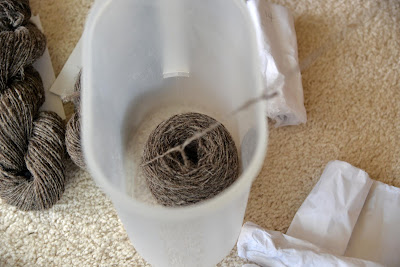With enough cute corgi pictures to keep it interesting ;-). And some stats at the end that will probably surprise you.
Even 20 looks overwhelmed with trying to decide how to decide which singles to ply to which to get the most evenly matched skeins in the end.
Here is what we did:
Re-weigh each finished ball. The reason? A big fluffy pile of wool doesn't necessarily weigh the same as a compressed ball of wool. I used my "science" scale to get really fussy technical.
I then put the ball in a water pitcher (so it wouldn't bounce all around the room) and pulling from the outside of the ball carefully wound it into a two yard skein.
Note yardage. I love, love, love having a counter on my skein winder*. It's life changing...well spinning life at least...but spinning is life...no wait, sheeps are life... ;-)
I tied a piece of yarn to the loose end of the single. I did that so I'd easily know which end I was supposed to start with for plying.
I also tied a couple of tight bow knots to secure the rest of the skein. I used the bows to be easy to untie but also to help keep track of the outsides of each skein.
Do the Jethro cipherin'. Skein #11 actually weighted 2.024 ounces. It is 220 yards long. Solve for x to get the yards per ounce, in this case 108.7.
You can do the next part by hand...or use a spreadsheet. I like math, but love spreadsheets ;-).
I sorted the skeins by yards per ounce and then paired of skein #6 with skein #17, #4 with #9, #3 with #7...
Making sure you have the two loose ends facing the same direction...
...and the bows are all facing up (if facing down then the skein is twisted)...
...and your skein winder securely anchored with a corgi butt...
...ply as usual. My skein winder has a tensioning feature and I cranked it down pretty tight so I didn't go free wheeling off into space.
The final results?
First I re-weighed all the plied skeins. The yardage of each skein could only be as long as the shortest single so there were leftovers on several of the skeins. The leftover singles were all on the thinner side (longer yardage per ounce) so when they were plied together, the resulting two ply is significantly thinner, hence they are separated out at the bottom.
Ply shrinkage - when you ply the two singles, the plied yard will end up shorter than the original singles because as you twist the two yarns together, the yarns are no longer straight. The more you twist them, the shorter the yarn will become.
That skein with the shrinkage of 14 was either plied with more twist or I wrote something down wrong. Just looking at the finished skein I can't see a significant difference from the others so regardless it will knit up just fine. Likewise with the shrinkage of 4 yards.
Overall, I am much happier with my finished yarn this time. The difference between skeins now is much less than any yarns I've spun previously. Plus I found it interesting to track all the stats.
While I was thinking along the lines of statistics, I decided to track my time spinning and plying. It took me 27 hours to spin the singles and 6 hours to ply them. I didn't figure in my time cipherin'. That would have been an embarrassing number ;-).
Want to take this a little further? If I paid myself $10 an hour, that's $330 just for the spinning work. It costs $10 per sheep for shearing and about an hour for skirting, so another $10 there. $24 to wash and $27.50 for processing into roving, not counting gas and time going up to the mill and back.
Just counting BASIC yearly costs for hay, grain, bedding, vet work...it costs us $100 to produce a fleece. That doesn't include mortgage, insurance, utilities, fuel, buying the sheep, farm equipment... Also, spinning wheels aren't cheap. Neither are the workshops I've traveled to take...
The moral of this story? I might just print this out and hand it to the next person who can't believe I can't sell them a handspun and hand knit sweater. That's $501.50 Just. For. The. Yarn. Figure in the weeks I spent knitting the Muffin sweater? Even if it wasn't Muffin...it would be priceless.
* * * * *
*My skein winder is from Nistock Farms. Even if they weren't good friends of ours, I would say this is the very best skein winder I've ever used. It's solid and stable, easy to use winding on or off and being able to easily track yardage is...life changing ;-).














No comments:
Post a Comment